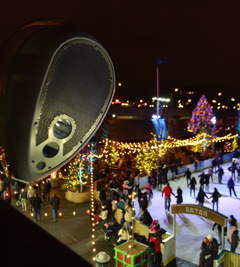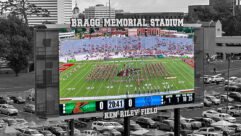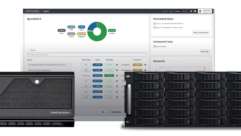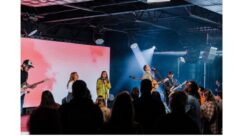
SVC Podcast – Show Notes – Show 139-1:
In this edition of the SVC Podcast, SVC Contributing Editor Bennett Liles talks with Jeremiah Leiter of Live Sound Company in Williamsport, MD about their installation of a new Deva system from PowerSoft for the RiverRink at Penn’s Landing, an Olympic sized skating rink in the Philadelphia area. Jeremiah details the capabilities of the sound, paging and camera system and discusses the installation in detail as well as the initial demonstration of the Deva System by PowerSoft.
Links of interest:
- Live Sound Co in Williamsport, MD
- The RiverRink at Penn’s Landing, site of the installation
- The PowerSoft Deva, a complete sound and video system
Download Podcast Here:
https://s3.amazonaws.com/nb-svc/public/public/139-1_Powersoft_Deva_Live_…
From Sound & Video Contractor Magazine, this is the SVC Podcast with Jeremiah Leiter. Show notes for the podcast are available on the web site of Sound & Video Contractor Magazine at svconline.com. With winter coming on, Philadelphia’s RiverRink at Penn’s Landing is a popular place for ice skaters. The Olympic-sized rink needed a sound and paging solution, but through Live Sound Company they got a lot more with the Deva system from PowerSoft. Jeremiah Leiter is going to tell us all the things it can do. That’s coming up next on the SVC Podcast. We’re sure glad to have you here on the SVC Podcast Jeremiah, from Live Sound Company in Williamsport, Maryland. There was an installation at the RiverRink using PowerSoft’s very versatile Deva system but before we get into the details on that, tell us about Live Sound Company. Live Sound Company, we are an installation and production company. We look at our business as two different sides. One side is the standard integration installation of audio, video and lighting products, and the other side of our company is live production, whether that’s touring systems, theaters, corporate events, sound for bands, things of that nature. [Timestamp: 1:27] Well, it sounds like you’ve got enough going on to keep everybody busy. Absolutely. Absolutely. Tell us about the RiverRink at Penn’s Landing. It looks like this is a place, especially during the winter, that gets busy with a lot of people showing up there. You did the system upgrade there so what did they want from the new PowerSoft Deva units that you put in for them? The RiverRink has been in existence for a few years and they used traditional methods of lighting, video and audio; all three separate systems to meet their needs. We originally approached the city of Philadelphia with the Deva product as a solution for them for many different needs around the city. When we were able to do the RiverRink for them as kind of a demo solution to highlight what the product features for them could be, running in tandem the system that they already had installed to show them with one solution you can have a security system, you can have video capturing, you can have audio playback, you can have lighting – again, whether it’s for a security feature or to light up a certain aisle way. Just kind of showing all the wonderful multimedia features of the Deva unit all in one application. [Timestamp: 2:45] Okay. Well, obviously the reason for selecting the Deva system is that it can do a number of different things without your having to install a bunch of different systems to do all of that. Correct. Correct. And like I said, the city was kind enough to find us a project to be able to highlight this for them because they have a lot of other projects in the city. They’re going to be doing a very large walking and biking trail which we felt this would be a good solution for, and some other projects. So like I said, it was a good place for us to demo the features of the product. [Timestamp: 3:14] And I think PowerSoft performed a demonstration of the Deva for you so how did that go? PowerSoft is a wonderful company. I’ve had a relationship with them for many years from other positions I’ve held with other companies. I knew about the Deva product a few years ago, even when it was just in its infancy stage just as a concept. We started talking to each other when I knew the product was going to be coming out and I started actively looking for a project like this that we could showcase the features of the Deva unit somewhere along here on the east coast in a major city application. As soon as we found something we reached back out to our partners at PowerSoft and they were absolutely wonderful to us to deal with. They actually packaged all the gear up in Italy and sent it over to us. They sent us their local people here in the United States. They sent one of their guys over from Italy that’s actually a programmer on the software side. So their support through this whole process was absolutely flawless and it was wonderful to work with them. [Timestamp: 4:14] And the Deva system hasn’t been out for very long so it would be very important for PowerSoft to get clients off on the right foot with it. That was a sentiment that both sides had; me as being an installer and an integrator and them being a manufacturer. I wanted to make sure that we represented the product well for them and we represented ourselves well so we didn’t put something in that wasn’t going to meet the client’s needs. So it was great that both sides of us really took pride in making sure that this first demo here in the United States was a success. [Timestamp: 4:45] And it’s important to remember that this is not just a music and paging system. It’s also a video system so they have a security aspect to it. I don’t know what the minimum light level for it is but I guess when people are there the place is lit up pretty well. Well, it’s interesting you bring that up. This multimedia unit is really, really cool. It has a sensor in it, which is basically a motion sensor. So if it’s at nighttime and you’re using it in, say, a security application, if something or somebody moves in front of the motion sensor there’s an LED light on it that is extremely bright. I think it’s around 540 lumens and approximately a 35-degree coverage angle on it. So you can actually light it up with the LED light in the area and then the camera can work, or the camera is actually infrared so it has nighttime and low-light capabilities as well. [Timestamp: 5:34] So the people there and all the skaters know that while they’re out there having fun they are being watched over and that there is a security system in place. Like I said, if we wanted to talk about the security just for a second, that’s the cool thing about the unit. It’s programmable. So let’s say at the skating rink for example, during the evening hours there’s families out skating. Not only is it providing surveillance, but they also wrote a little piece of code in that it was randomly taking still shots, photographs, of the families out there enjoying themselves and then posting them on video monitors around the ice rink for families to kind of say oh, look at the pictures and kind of a multimedia experience. And at the same time it can be used for surveillance. And then at nighttime when the park is closed, the Deva system turns into a complete security-type system so then we have the cameras only being turned on when they’re being triggered by the motion detector and capturing whatever video footage that would be. Also it could turn on a light and also be preprogrammed to give some kind of message, whether that’s a message of you’re in a secure facility or the park is currently closed, please leave, you know what I mean? You can program this unit to do all kinds of things. [Timestamp: 6:47] Well there is a whole lot to set up on it, but how easy is that to do? Where is the control point for the system located? Honestly that’s another really good question. It’s actually quite simple. They have what I call a GUI interface. So they have a piece of software that’s Linux-based – at least the last we used it, it was Linux-based – where everything is real easy. All of the menus are set up for you. It’s a drag-and-drop, click, turn on/off type of functionality that you would come to expect from any kind of system. Very easy to use, very quick integration. And basically the command center can be anywhere. The way that we communicate to these units it can either be hardwired over Ethernet or you can set up a Wi-Fi system with them. They’re all addressable. We put a Wi-Fi system in the area. They’re all hookup via Wi-Fi, all addressable separate and you can communicate to each unit that way. [Timestamp: 7:42] Well it would keep the wiring simpler, and so keep the setup maybe more quick and easy. Absolutely. And I don’t know if they’ve released it yet or not, what was in the works when we did this was also another application with SIM cards. So if you were out, say, in a remote location and setting up a redundant Wi-Fi network would not be necessarily feasible, you could use a SIM card, which is wireless cell phone technology, to actually uplink them to a satellite and communicate with them that way. [Timestamp: 8:13] Okay, so you don’t have to deal with any sort of RF coordination or anything like that. No, no. I mean the cool thing with that, too, is – which I know we haven’t hit on it yet – there’s also an internal battery in the unit and it has a solar panel. You truly can put one of these out in the middle of a parking lot or a hiking trail and as long as it has sunlight to charge up the internal battery and we can hook it up either over Wi-Fi or over a SIM card, there’s actually – it’s all self-contained. You don’t need any physical wiring for this unit. [Timestamp: 8:45] All right, a green aspect to it as well. How does that system do its initial test? How did that go, and what sort of additional tweaking did you have to do? There were very few tweaks, which really, really surprised me. The tweaks that we ran into, like I said PowerSoft sent over one of their head programmers that was right there to help us get through any of the tweaks or any of the little things that may have been operator error on our end – setting up the Wi-Fi network or when the client said hey, can we have a photo collage? You say yeah, let me write a quick program real quick to handle that for you. So it’s really cool that the PowerSoft, they tried to think of all the applications for this, but I guess because of the way the technology is written, with their programmer they can design it to do a lot of other things in custom applications for a particular client. [Timestamp: 9:35] Well, this is a fantastic system doing a whole lot of different things all in one small package, and it’s been great hearing about how you put this in. The Deva system from PowerSoft and the installation for RiverRink at Penn’s Landing. Jeremiah Leiter with Live Sound Company. Thanks for giving us the details on it. All right. Thank you very much. I appreciate you taking the time with us. Thank you for being here with us for the SVC Podcast with Jeremiah Leiter. Show notes are available on the website of Sound & Video Contractor Magazine at svconline.com. Join us next week for Part 2 when Jeremiah will take us into the specs and explain the solar power options on the Deva. That’s on the next SVC Podcast.










